Imagine spending your life barefoot. Sure, the bottoms of your feet will be tough, but you’ll still be vulnerable to all sorts of injuries.
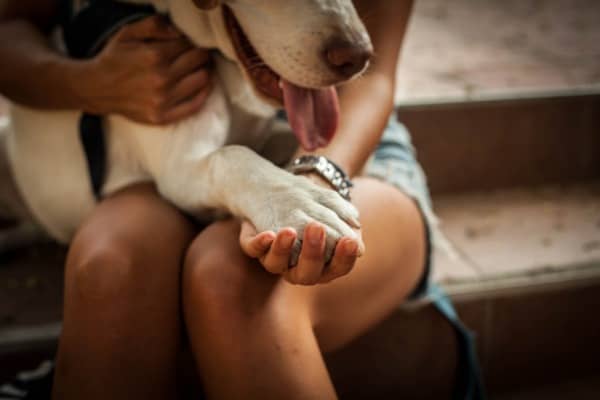
Dogs don’t have to imagine this scenario. While their feet are made to be bare, there are still environmental factors that can become a problem.
So have you noticed your dog has a swollen dog paw between the toes? Or maybe your dog’s paw is red between their pads.
There could be several reasons why your dog’s paw is red or swollen.
Finding the underlying problem is the first thing to do to get your dog on the road to recovery.
Sometimes the diagnosis needs the helping hand of a vet, but often, pet parents can narrow down the issue on their own.
No one wants to see their pet uncomfortable or in ill-health – we want our dogs to be happy and healthy.
We’ll list through the common causes of why your dog’s feet seem to be bothering them and what you can do to help.
Blame the Pests
No matter where we live, we can’t escape bugs. If you’re in a rural area, you might have an even harder time dealing with the creepy crawlies that invade your property.
City dwellers aren’t entirely safe, either. A large number of irritating bugs make their home in the heart of urban areas.
Mosquitoes, ticks, and other bothersome insects don’t discriminate – they could be biting your dog, too.
Ticks
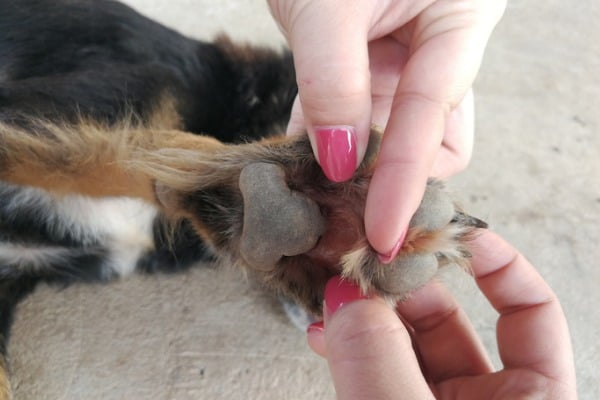
Catching your dog licking and chewing at their paws could be an indicator a tick has taken up residence there.
Dogs are very helpful in letting you know when something is stuck in their paws, so pay attention if they seem more interested in that area.
Check between your dog’s toes and paw pads for a tick. It’s important to do frequent tick checks, as some ticks carry pretty nasty diseases.
But if you can get the tick out within 24 hours, it probably hasn’t had time to transmit any infections.
Remove ticks with tweezers or specialized tools made for tick removal.
Avoid using your bare hands, as you could come into contact with pathogens.
Never remove a tick from your dog by burning it. Not only can you accidentally burn your dog, but it can also cause the tick to “vomit” and possibly transmit diseases.
Keep the tick long enough to identify if it’s a disease-carrying species.
Once ticks have been embedded long enough, they will bloat, which makes it difficult to identify them.
If you live in the range of any disease-carrying ticks, save it for your vet to test for diseases such as Lyme or Rocky Mountain Spotted Fever.
If you need to save a tick, you’ll have to secure it in a sealable container.
Use a jar with a lid or a Ziploc baggie; ticks can crawl out of most containers that aren’t sealed.
The tick can be disposed of if there’s no worry of infection, but don’t try to throw it in the trash. Flushing it down the toilet is your best bet.
If you find a tick in your dog’s paw, check the rest of him thoroughly for others.
Removing them ASAP is the best way to prevent a dog paw infection between the toes, aside from anti-tick medications.
Once you’ve removed the tick, your dog should stop obsessing over their paw.
Once in a while, the tick’s head will remain stuck under the skin, but it will be expelled by your dog’s body in short order.
Washing the bite with rubbing alcohol or antibacterial soap is a good safety measure.
Mosquitoes
They’re the arch-enemy of pets as much as they are to us. Long-haired dogs have some natural protection against them, but no dog is immune to getting bitten by these awful pests.
A dog chewing their foot could be trying to scratch a mosquito bite.
Mosquito bites on dogs will present themselves much like they do in humans; a red raised bump.
Remember, there could be other causes for red, swollen spots, so be careful trying to treat them at home.
If your dog’s itching is making them miserable, they can be administered antihistamines such as Benadryl – but always clear this with your vet first.
A quick phone call with their office can tell you which dosages are best and if it’s a safe option for your particular dog.
Once your dog has a mosquito bite, there’s not much else you can do except try to keep it from happening again.
Bites on sensitive areas like feet can be maddening for your dog, so using dog-safe bug repellant is one of the best things you can do for your best pal.
While some antihistamines are safe to give your pet, bug spray is something that should not be shared.
The main ingredient in most bug sprays, DEET, is very dangerous to dogs.
Stock your home with pet-safe alternatives, and don’t forget to treat your dog’s feet with repellants before setting off into the bug jungle.
Bees or Wasps

Stinging insects are a pain – literally. Now think about how it would feel if you stepped on one with your bare foot.
A dog who has been stung in the foot might present swelling and could even be limping, depending on the severity of their reaction.
The first thing to do if you suspect your dog has been stung by a bee is to try and locate the stinger.
Since some species leave the stinger behind, it could be causing your dog further irritation. If you can locate it, remove it with tweezers or a credit card.
An antihistamine can also be helpful in this situation. But there are some warning signs that indicate your dog will need a vet’s attention.
Dogs can have anaphylactic reactions to bee stings, just like some people do.
Weakness, shaking, labored breathing, diarrhea, and vomiting all warrant an immediate trip to the vet.
Getting your dog help if they experience these symptoms is vital – their airways could close without proper medication.
There’s not a lot you can do to avoid your dog accidentally stepping on a stinging insect, but you can help them through it.
Bugs are Everywhere
Unless we want to lock our dogs indoors, we can’t avoid insects.
And sometimes, the little pests make their way inside no matter what we do.
Pet-safe sprays, oral medications, and repellant collars can all help reduce the chances insect bites will plague your dog.
Injuries and Diseases
If your dog’s paw is swollen in between their toes, bugs might not be to blame. This is especially true if your dog refuses to go on a walk.
Some medical conditions and injuries can cause your dog to display symptoms similar to insect bites.
You can still inspect your dog’s paws to rule out foreign objects, but sometimes you might find their issue requires the care of a vet.
Broken Nail
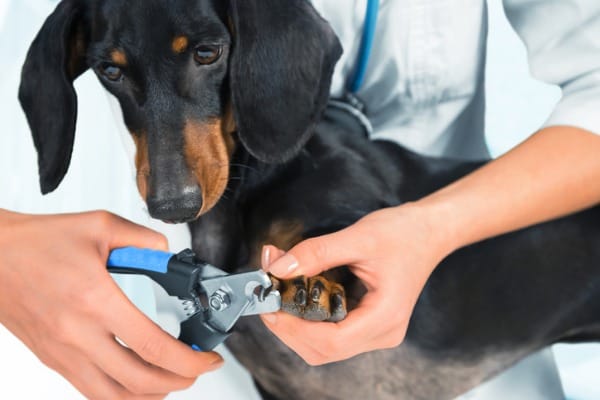
Dogs can break their nails by playing, running, or sometimes just by having a clumsy accident in the house.
The longer your dog’s nails are, the easier they are to get snagged and broken, so try to keep them trimmed regularly. But even dogs with short nails can break them.
A dog with a broken nail could be limping and licking their toes; you might see some swelling and could even find small amounts of blood tracked on the floor.
Dog’s nails have a “quick” – a blood vessel with nerves inside the nail.
It doesn’t typically grow the entire length of the nail, which is why trimming your dog’s nails isn’t painful (unless you nip the quick, which even the most experienced vets have done before).
Broken nails can break or expose the quick. It’s similar to cutting your own fingernail too short and breaking your skin.
Don’t panic – while it is painful for your dog, it’s rarely serious. You’ll need to assess the injury if your dog allows you to.
A dog in so much pain that they won’t let you touch their paw needs to see a vet.
They could have an infection as a result of a broken nail.
There are things you can do to treat the broken nail, even if only to patch up your dog before heading to the vet.
In a pinch, flour or cornstarch can be used to stop bleeding until your vet can tend to your dog’s nail.
Trimming nails might be a battle between you and your dog, but it’s the best way to prevent broken or cracked nails that can cause your dog pain.
If you’re not comfortable doing it yourself, paying a veterinary technician or trusted groomer to do it is a small cost. Surprise vet bills and upset dogs are well worth avoiding.
Something Sharp
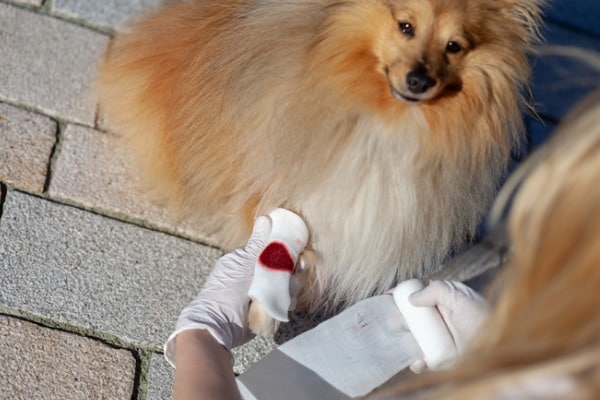
It’s a sad fact that there’s litter pretty much everywhere.
The beach, hiking trails, and even your backyard aren’t necessarily free of sharp objects that your dog could step on.
If your dog has a swollen paw or toe, is limping, or is trying to chew their paw, you can try to inspect it.
Tacks, broken glass, fish hooks, sewing needles, metal shavings, and cockle burrs can all easily get stuck in your dog’s paw pads.
It might not even be something that punctured your dog’s paws; sometimes, small objects can become wedged in your dog’s toes, causing pain and irritation.
If you find something that hasn’t broken the skin, such as a small pebble, or even a Lego, you can try to remove it gently.
You know your dog best and if they’ll allow you to assist them without needing a trip to the vet.
In cases where the skin has been broken, locating a foreign object means a trip to see the vet.
They will be able to assess if the object can be removed safely, if it’s best for your dog to be sedated, or if further treatment is needed.
It’s important to address sharp objects quickly because if a dog manages to chew them out, they could cause themselves further damage.
The object could also become stuck in their mouth – or left on the floor for your bare foot to find.
Dog booties might seem like an extreme measure to keep your dog’s paw pads safe from sharp things. But in cases where litter is rampant, it could be well worth it.
Swimming, for example, is a prime opportunity for your dog to step on glass or fishing hooks. Dog booties and life vests are two wise investments for your water-loving pup.
Inside your home, make sure sewing supplies, hooks, and nails or tacks are kept away from your dog.
If you break glass on the floor, keep your dog from the area until you’ve had a chance to clean it up.
In most cases, busting out the vacuum is enough to get your dog to swiftly vacate the area.
Abscesses
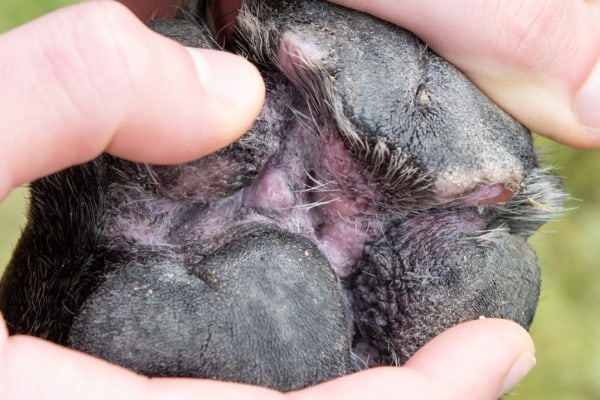
Known as interdigital furunculosis, this condition is basically an infected ingrown hair between your dog’s toes.
Webbed-footed breeds such as Chesapeake Bay Retrievers have a higher risk of developing interdigital furunculosis.
Bristly-haired dogs like an English Bulldogs could also be predisposed to the condition.
This is a medical issue that can only be diagnosed by your vet, and the first sign is a red bump on or between the dog’s toes.
A paw infection between your dog’s toes could require draining, biopsies to rule out abnormal growths, and antibiotics.
There’s not a lot you can do to prevent the condition, but it is fortunately easily treatable.
Allergies
Allergens from grass, mold and certain plants can cause your dog to itch.
They also could be sensitive to lawn treatments, pesticides, or any other chemical they’ve been exposed to while walking.
A dog who scratches or chews at irritated paws could display swelling.
Treatment for inflamed paws can be as simple as washing their feet after they’ve been outside. Normal dog shampoo and warm water are sufficient to remove allergens.
If the excessive licking is chronic – meaning it doesn’t stop with simple paw washing – you can try an iodine or similar paw soak.
Your dog might not appreciate a “spa” day as much as you do, but in the long run, it could relieve their itchy, irritated paws.
When in Doubt, Ask the Vet
In some rare cases, the unknown cause for your dog’s swollen, red, painful toes or pads could be more serious.
Abnormal growths, cysts that may have ruptured, and bone issues need to be ruled out.
Either way, the vast majority of causes of your dog’s redness between toes have good treatment options.
Weather Woes
The weather can have an impact on your dog’s paw health, whether it’s blistering hot or frigid outside.
Playing in the snow can be your dog’s favorite pastime and also the reason their toes are red.
Similarly, summer-loving pups can experience issues from playing outdoors – and not just from bees.
Frosty Paws
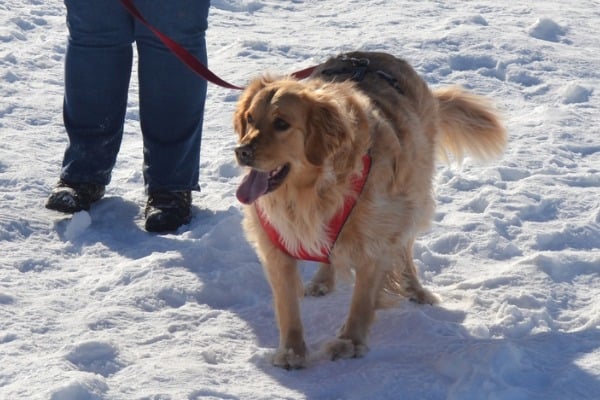
Some dogs are husky wannabes. But walking in a winter wonderland might require booties for any dog.
As much as your dog hates wearing booties, it could protect them from snow and ice balling up in between their toes.
While they will eventually melt, ice and snowballs embedded in between your dog’s toes can be intrepid little irritants.
And as innocent as a little snow may seem, too much of it impacted in your dog’s toes can cause cracking and bleeding.
If your dog just doesn’t wear booties, you’ll need to break up winter playtime by cleaning their paws out several times an hour.
Or, you can invest in specialized paw balm – designed initially for sled dogs, it can be used on your winter-loving pup to keep ice and snowballs from forming.
Protect the Feet from Heat
Summer weather presents its own issues to your dog’s paws. Hot pavement and tarry roads are the two biggest adversaries when it comes to letting your pet enjoy the outdoors.
Asphalt can heat up very fast, even if the air temperature isn’t overly hot.
A good way to know if the pavement is too hot for your dog is to put the back of your hand or your bare foot on it – if you can’t comfortably leave it there for ten seconds, then your dog can’t tolerate it.
This goes for sidewalks, sand, and dirt trails as well. You might find your dog refuses to walk if conditions aren’t favorable.
The best solution is to walk your dog in the early morning or evening hours when the sun isn’t at its peak.
Of course, dog booties can provide a layer of protection, but not all dogs think this is a fair trade.
Tar can heat and become sticky in the hot summer sun, so walking your dog on the road could cause tar to gum up their toes.
A dog with tarry feet might lick and chew; their paws can become irritated as a result.
Tar can be removed by using an oil rinse; avoid mineral oil, and use something that won’t be harmful if your dog accidentally ingests it – such as coconut oil.
Scrape away any tar residue before applying the oil. Your dog will need to be supervised, as the oil needs to sit on the area to be effective.
Wrapping your dog’s foot in a plastic bag is helpful, but again, you’ll have to watch them.
Let it soak for as long as you can, and use a rag to rub away the remaining tar.
Wash off the oil with regular dog shampoo after you’ve wiped off the tar. This also works if your dog has tree sap stuck in their paws.
If your dog’s paws have become burned from walking on hot surfaces, call your vet for treatment instructions – and be sure to keep them off the offending hot surfaces in the meantime.
Booties – Yay or Nay?
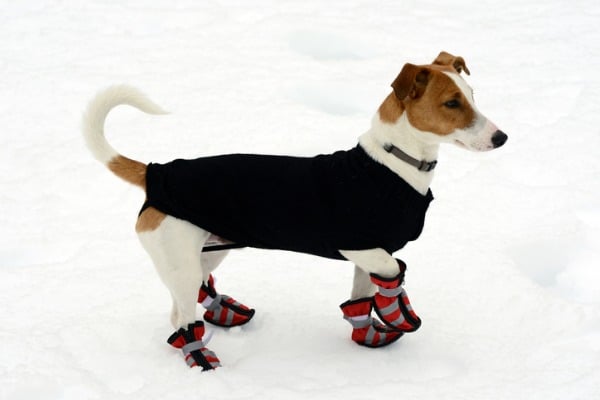
Putting dog booties on your fur baby is the easiest way to protect their feet from the elements – that is, if they cooperate.
Some dogs don’t seem to mind them at all, but some dogs outright refuse to wear them.
And some dogs walk funny for a while but seem to accept them after they get used to them.
If you opt to buy booties for your dog, make sure they’re made for the specific purpose you’re using them for.
Some offer only protection from heat, some are designed to keep out sharp objects, and some are more universal.
And if your dog is having none of it? At least there are some pretty simple measures you can take to keep your dog’s feet safe and sound.
Precious Paws
As the saying goes, dogs leave pawprints across our hearts. We can return the favor by keeping those paws safe and sound.
A dog with a swollen toe or paw can seem like a drama queen – and honestly, sometimes they are.
But a limping, distressed dog with a paw issue could be asking you for help, and even if they are overreacting, it’s up to us as their humans to rule out serious issues.
When you have dog paws red between the toes, be proactive about your dog’s health, and hopefully, the only paw-related issue you’ll have is muddy tracks on your floor.
